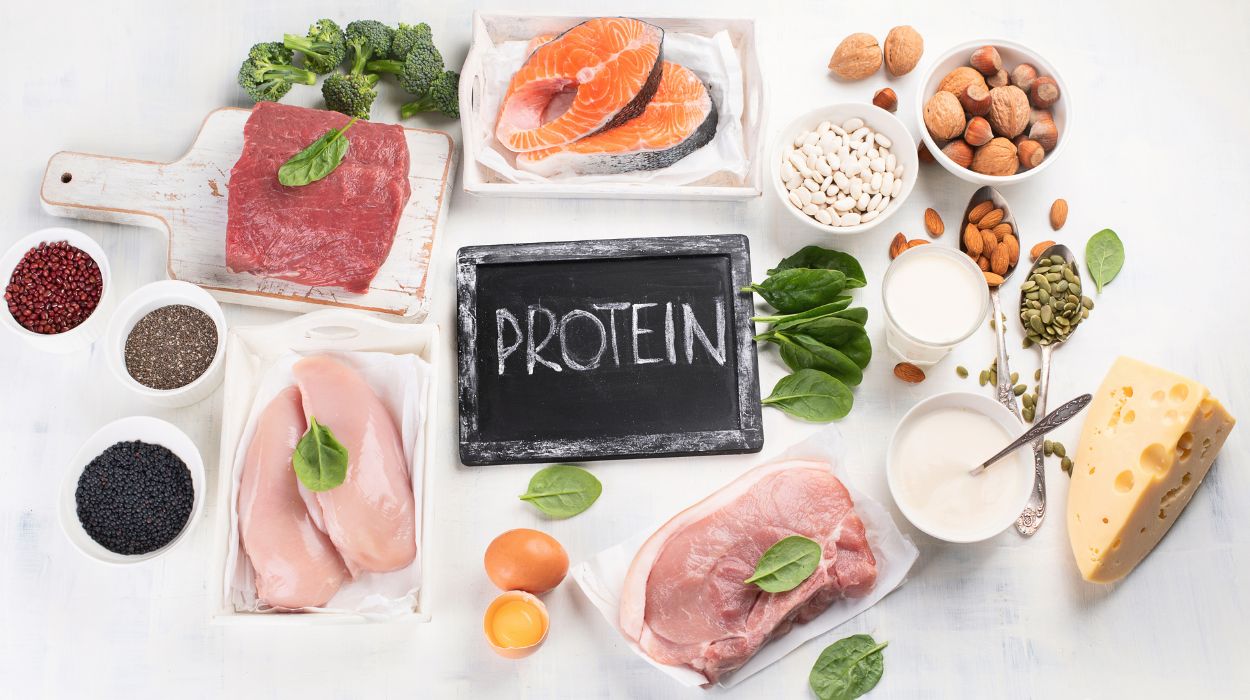How To Lose Fat Without Losing Muscle: 5 Science-Backed Tips 2024

So you spend week after week at the gym working your way towards your fitness goals. However, you are not seeing the results that you had hoped for. How to lose fat without losing muscle?
The muscles you have been building seem to be hidden behind squishy fat. Well, what if we told you that you could lose your body fat and preserve your muscle gains?
Let us take a look.
5 Tips Reduce Body Fat Without Losing Muscle
Reducing body fat while preserving your muscles can be difficult. It involves the right combination of diet and exercise. These tips should help you achieve your results:
- Eat more protein
- Do moderate cardio
- Strength train
- Moderate calorie deficit
- Use supplements
Most weight-loss diets cannot direct your body to burn only fat for energy. Therefore, you will probably burn amino acids from your muscles for fuel too. Strict dieting and exercise could help you lose weight but might not give you the toned body that you desire.
If you are looking to lose fat without losing muscle, it is important you strike a balance. Committing to a diet that promotes weight loss while engaging in muscle-maintaining exercises can help you reach your goals.
How To Lose Fat Without Losing Muscle
Eat More Protein

Proteins are important if you want to maintain and build muscles. Indeed, your muscles are made of proteins, so it makes sense that increasing your dietary protein intake will help build your muscles.
Physical activity and exercise can cause microtears in your muscles. Healing from these minute injuries helps you build muscle.
How much protein do you need?
Studies support getting about 0.8-1.2g[1] of protein per pound of your weight daily. For instance, if you weigh 140 pounds, you would be looking at consuming about 168g of protein daily. However, consuming that much protein can be daunting.
That is where protein supplements come in. Taking whey protein could help you meet up with your daily protein needs. That extra 50g protein boost from your protein shake makes getting the rest from your meals much easier.
Does the timing matter for protein consumption?
Some people believe in taking protein right before a workout while others recommend protein intake after your workout. However, studies[2] show that it does not really matter.
Whichever routine you decide to choose, taking your whey protein shake close to your workout could help you increase your protein intake to preserve lean muscle mass.
The type of proteins you are taking is also important.
Lean protein is best if you want to lose fat without losing muscle. It helps you get all the protein goodness for your muscles without the fat. So, lean meats such as chicken and fish are better protein sources than pork or beef for your muscles.
Protein sources that are high in fat are calorie-dense. Therefore, a little goes a long way and it is a lot easier to pack on the calories from small portions.
Moderate Cardio

Jumping jacks, running, skipping, and walking, are all popular cardio exercises for losing weight.
Cardio gets your heart pumping to burn calories and you will likely break into a sweat after a good session. If your only goal is successful weight loss, getting a good amount of aerobic exercise daily should get you on track.
However, if you are looking to preserve muscle mass, you would need to tweak your exercise routine a bit.
While cardio workouts are great for weight loss, some people avoid them while building muscle. The erroneous belief that cardio could be detrimental to muscle gain could be robbing you of its benefits.
A study found that regular cardio could be beneficial for maintaining lean muscle mass.
When it comes to supporting your muscle gains with cardio, high-intensity interval training is more beneficial than duration. Spending hours on the treadmill might not cut it.
A weekly cardio routine of 150-180 minutes aiming for 80% of your maximum heart rate might help tone your muscles.
However, excessive cardio is a no-no. That is because excessive exercise could make recovery difficult especially if you are in an energy-deficient state. Therefore, it could affect your results.
Consider a routine that lets you switch your exercise routine. Alternating between cardio and strength training might give you better results.
However, consider putting a considerable gap between both exercises.
Strength Train

Strength training workouts are essential for muscle growth and they deserve attention too.
These exercises such as weight lifting or working against resistance can help prevent you from losing muscle mass.
A study on three groups following aerobic training, resistance training, and no training showed that the resistance training group lost almost no muscle at all.
However, all three groups showed significant weight loss.
Therefore reiterating your need for resistance and weight training if you want to lose fat without losing muscle.
These strength and resistance training workouts such as weight training put lots of tension on your muscle that causes microscopic tears and muscle protein breakdown.
This phase is closely followed by the muscle protein synthesis phase where the tissue damage is repaired. A high-protein diet is essential in this repair phase for preserving muscle mass.
When the rate of muscle protein repair is higher than the rate of muscle protein breakdown, you will experience muscle growth. On the flip side, faster muscle protein breakdown than muscle protein repair equals loss of muscle mass.
If you are hoping to protect your muscle from breakdown, aim for nearly equal rates of muscle protein breakdown and repair.
Nevertheless, your exercise intensity during your weight loss journey should be lower. Your dietary changes might give you less energy than usual and pushing yourself could increase your risk of injuries.
It is important that you involve all parts of your body and split your workouts to include upper-body and lower-body days.
Squeezing in your strength and resistance exercises 4-5 times each week might be sufficient to maintain muscle mass.
You also need sufficient recovery time for your weight training efforts to be successful.
If you are also doing cardio workouts, you will need a significant time interval between both exercise groups.
Keep scheduling your cardio and strength training on different days. If you cannot get them on separate days, consider putting several hours between them.
The right intensity and form are essential. If your form is not right, you might miss out on the huge benefits of your workout routine or worse still, hurt yourself.
How many reps are necessary for each exercise? Ask a professional.
Getting professional help might save you from bumps and sprains, and bring you closer to your goal.
A personal trainer will help you develop the right exercise regimen featuring various types of exercises that you might find helpful.
They will also help you perfect your form while exercising so that you are less likely to get hurt.
A personal trainer might require significant financial investment from you. However, postponing it could also postpone your results.
If you are tight on funds, consider getting a personal trainer at the beginning of your fitness journey and moving forward alone once you have got a hang of it.
Your trainer will guide you on the number of reps you need for each workout for muscle maintenance.
Moderate Calorie Deficit

If you have been on your fitness journey for a while, you have probably heard that a caloric deficit diet is crucial to weight loss.
It is true when you consume fewer calories than your body needs daily, it causes your body to reach into its energy reserves for fuel.
However, your body is not picky when it needs energy. So, it will break down some stores of fat as well as muscle protein to fuel your body.
That is why striking a balance is vital if you want to preserve your muscle. Fad diets that place strict restrictions on your calorie intake could cost you your muscle development.
It can be difficult to build or maintain muscle on diets such as intermittent fasting. However, you need only the right tips for building muscle while on this diet
Starvation[3] to lose weight is also not a good idea as it could cause you to gain even more weight in the long run.
It could be difficult to stick to such restrictive diets and you might find yourself cheating on your diet frequently by consuming more calories.
Muscle growth requires calorie surplus but since you are looking to burn fat, not muscle, you will need to find a middle ground.
Limiting your calorie intake by no more than 500 calories daily should be sufficient for shedding fat without causing much damage to your muscle gains.
To maintain your muscles, even on a caloric deficit diet, you should still ensure that you are getting proper nutrition.
Getting enough lean proteins will help you keep those precious muscles of yours. Furthermore, proteins fill you up for longer, so keeping to your calorie-deficit diet is less tedious.
Fiber-rich meals are also excellent at maintaining satiety, so that is something to consider.
Moderate amounts of healthy fats and carbs should also feature on your plate.
Supplements

Dietary supplements provide a way for safe and effective weight loss. However, these results are only under the expert guidance of your healthcare provider.
Not all supplements are approved for you if you have specific health conditions. Being on certain medications could also exclude you from being eligible to take specific supplements.
CBD oil t from the hemp plant shows promise at promoting weight loss[4]. It does not contain significant THC, therefore, it has no psychoactive properties.
Post-workout soreness could affect your exercise efficiency.
Researchers observed that CBD oil is an effective anti-inflammatory[5] agent and it could help improve your post-workout inflammation and soreness.
Less soreness means that you can get right back into your workout routine.
Sleep is also essential for weight loss and muscle strength and growth. If you are struggling with insomnia, supplements like CBD oil that promote sleep[6] and reduce stress might be helpful.
Branched-chain amino acids (BCAAs) is another supplement that could reduce the impact of muscle tissue loss[7] during your weight loss journey.
BCAAs supply your body with the essential amino acids needed for muscle tissue repair. They help ensure your muscles are getting all the nutrition they need even if you are on a caloric deficit diet.
If fatigue is affecting your exercise performance, taking your BCAAs before, during, or after your workout could help you improve your performance.
Weight Loss Vs Fat Loss
Most times we used the terms weight loss and fat loss interchangeably, often switching from one to the other in a sentence.
However, are they the same?
Not entirely.
Weight loss is a broader term that often covers fat loss. Losing weight simply means that the figures on your scale are dropping. Essentially, you are becoming lighter.
On the other hand, fat loss means that you are losing your fat stores. Fat loss can also translate to weight loss but you cannot tell how much fat you have lost by simply climbing on a scale.
That is why people who weigh the same do not all have the same type of bodies. For instance, if you looked at a lineup of 140-pound women, you would see different body types. Fat-to-muscle ratio and fat distribution could affect how your weight looks on you.
Multiple factors contribute to weight loss. These factors include water loss, muscle breakdown, and fat loss.
A combination of these factors gives you the results you see when you climb the scale. However, losing weight alone might not give you the body you desire. You could hit your weight loss goals and still not like how your body has turned out.
That is where targeting fat loss comes in. Following specific routines that maximize fat loss and maintain muscle mass is essential to achieving a toned look.
These strategies include:
- Following a moderate calorie deficit diet
- Using the right mix of cardio and strength training workouts to burn fat and tone muscles
- Seek professional guidance from a personal trainer
- Eat healthy foods, prioritizing lean protein
- Use supplements to encourage fat loss and promote muscle development
Preserving your muscles during weight loss could have benefits for your overall health. High fat-to-muscle ratio[8] could increase your risk of specific health conditions such as diabetes and heart disease.
How To Measure Fat Loss
Measuring exactly how much fat you have lost can be challenging. Your bathroom scale will not cut it.
Can you tell me how much fat you have lost?
There are ways to measure fat loss. Your bathroom scale can help you compare your current body weight with your previous body weight but the weight lost includes water weight and possible muscle protein breakdown.
A few techniques to measure your body fat include:
- Body circumference measurement
- Skinfold calipers
- Body fat scales
Taking note of your circumference can help you keep track of your fat loss even if you do not see changes when you climb the scales.
For men, measuring your neck and abdomen should paint a fair picture while women might need to also measure their hips to track their fat loss.
Skinfold calipers have a rich history of body fat measurement. With your skinfold calipers, you can measure changes in the thickness of subcutaneous fat in three or seven body areas.
Getting accurate results from Skinfold calipers depends on your skill so you will need some practice to perfect yours.
Body fat scales typically measure your body fat percentage using bioelectrical impedance analysis (BIA). They send up a weak electrical current through your body for fat composition analysis.
For a more accurate reading, do not limit yourself to a single body fat composition method. Combining two or more of these options could help you track your body changes better.
Final Thoughts
Maximizing your fat loss while preserving your muscle mass can be tricky. A toned body can be attractive but it also holds health benefits.
Higher body fat to muscle ratio could increase your risk of certain health conditions such as diabetes and heart disease.
To achieve a toned look, you could:
- Eat more protein
- Do moderate cardio
- Strength train
- Moderate calorie deficit
- Use supplements
As you follow these techniques, you could track your fat loss using skinfold calipers, body fat scales, and body circumference measurements.
+ 8 sources
Health Canal avoids using tertiary references. We have strict sourcing guidelines and rely on peer-reviewed studies, academic researches from medical associations and institutions. To ensure the accuracy of articles in Health Canal, you can read more about the editorial process here
- Hector, A.J. and Phillips, S.M. (2018). Protein Recommendations for Weight Loss in Elite Athletes: A Focus on Body Composition and Performance. International Journal of Sport Nutrition and Exercise Metabolism, [online] 28(2), pp.170–177. Available at: https://pubmed.ncbi.nlm.nih.gov/29182451/
- Schoenfeld, B.J., Aragon, A., Wilborn, C., Urbina, S.L., Hayward, S.E. and Krieger, J. (2017). Pre- versus post-exercise protein intake has similar effects on muscular adaptations. PeerJ, [online] 5, p.e2825. Available at: https://www.ncbi.nlm.nih.gov/pmc/articles/PMC5214805/
- NHS Choices (2021). 10 weight loss myths – Healthy weight. [online] Available at: https://www.nhs.uk/live-well/healthy-weight/ten-weight-loss-myths/
- Google.com. (2021). Redirecting. [online] Available at: https://www.google.com/url?q=https://www.ncbi.nlm.nih.gov/pmc/articles/PMC6163475/&sa=D&source=editors&ust=1624677012148000&usg=AOvVaw1bsB-Ve3QDLSOSSs3vwRVt
- Rudroff, T. and Sosnoff, J. (2018). Cannabidiol to Improve Mobility in People with Multiple Sclerosis. Frontiers in Neurology, [online] 9. Available at: https://www.frontiersin.org/articles/10.3389/fneur.2018.00183/full
- Google.com. (2021). Redirecting. [online] Available at: https://www.google.com/url?q=https://www.ncbi.nlm.nih.gov/pmc/articles/PMC7338332/&sa=D&source=editors&ust=1624677027880000&usg=AOvVaw0q_gBCC6UQu9jaazW4eD3x
- Howatson, G., Hoad, M., Goodall, S., Tallent, J., Bell, P.G. and French, D.N. (2012). Exercise-induced muscle damage is reduced in resistance-trained males by branched chain amino acids: a randomized, double-blind, placebo controlled study. Journal of the International Society of Sports Nutrition, [online] 9(1), p.20. Available at: https://jissn.biomedcentral.com/articles/10.1186/1550-2783-9-20
- Google.com. (2021). Redirecting. [online] Available at: https://www.google.com/url?q=https://www.ncbi.nlm.nih.gov/pmc/articles/PMC6456204/&sa=D&source=editors&ust=1624677040161000&usg=AOvVaw2I6kCqvwt5eX0f4apvAoKB



